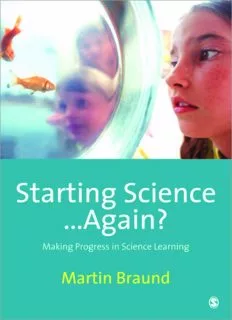
Starting Science...Again?: Making Progress in Science Learning PDF
Preview Starting Science...Again?: Making Progress in Science Learning
Braund(Martin)-Prelims:00-Braund(Martin)-Ch-Prelims 8/26/2008 11:55 AM Page i Starting Science … Again? Braund(Martin)-Prelims:00-Braund(Martin)-Ch-Prelims 8/26/2008 11:55 AM Page ii Braund(Martin)-Prelims:00-Braund(Martin)-Ch-Prelims 8/26/2008 11:55 AM Page iii Starting Science … again? Making Progress in Science Learning Martin Braund Braund(Martin)-Prelims:00-Braund(Martin)-Ch-Prelims 8/26/2008 11:55 AM Page iv ©MartinBraund2008;Chapter5©CeliaMoore; Chapter9©MartinBraundandCeliaMoore. Firstpublished2008 Apartfromanyfairdealingforthepurposesof researchorprivatestudy,orcriticismorreview,as permittedundertheCopyright,DesignsandPatentsAct, 1988,thispublicationmaybereproduced,storedor transmittedinanyform,orbyanymeans,onlywith thepriorpermissioninwritingofthepublishers, orinthecaseofreprographicreproduction,inaccordance withthetermsoflicencesissuedbytheCopyrightLicensing Agency.Enquiriesconcerningreproductionoutsidethose termsshouldbesenttothepublishers. SAGEPublicationsLtd 1Oliver’sYard 55CityRoad LondonEC1Y1SP SAGEPublicationsInc. 2455TellerRoad ThousandOaks,California91320 SAGEPublicationsIndiaPvtLtd B1/I1MohanCooperativeIndustrialArea MathuraRoad NewDelhi110044 SAGEPublicationsAsia-PacificPteLtd 33PekinStreet#02-01 FarEastSquare Singapore048763 LibraryofCongressControlNumber:2008933209 BritishLibraryCataloguinginPublicationData AcataloguerecordforthisbookisavailablefromtheBritishLibrary ISBN978-1-84787-008-7 ISBN978-1-84787-009-4(pbk) TypesetbyC&MDigitals(P)Ltd.,Chennai,India PrintedinGreatBritainbytheCromwellPress,Trowbridge,Wiltshire Printedonpaperfromsustainableresources Braund(Martin)-Prelims:00-Braund(Martin)-Ch-Prelims 8/26/2008 11:55 AM Page v To Stephen and Hannah. May the transitions in your lives be smooth and trouble free. Braund(Martin)-Prelims:00-Braund(Martin)-Ch-Prelims 8/26/2008 11:55 AM Page vi Braund(Martin)-Prelims:00-Braund(Martin)-Ch-Prelims 8/26/2008 11:55 AM Page vii Contents Preface: a tale of two entrants ix Acknowledgements xv Introduction 1 1 Progression and continuity in learning science 5 Continuity and progression explained. Progression in conceptual and procedural understanding. Mapping progression using from → to statements. Integrated model of progression in learning science 2 Moving up – but why don’t they always move on? 22 Evidence of post-transfer regression. Explaining post-transfer regression and what can be done to deal with it 3 Moving to the big school: Part 1 – children’s voices 35 Pupils’ attitudes to science and practical work at school and in work. Pupils’ aspirations and fears about transfer. Differences and similarities between science at primary and secondary school. Implications for pupils’ scientific literacy and bridging work 4 Moving to the big school: Part 2 – teachers’ voices 52 Assessment differences. Differences in teaching. Teachers’ explanations for post-transfer regression 5 Bridging the divide: Part 1 63 Celia Moore Every Child Matters (especially at transfers). The administrative bridge. Building social bridges – open evenings, induction days and peer mentoring. Building curriculum and pedagogic bridges. Learning to learn 6 Bridging the divide: Part 2 – science bridging units 79 Design and teaching of STAY bridging units. Teaching to improve continuity and progression. Criticisms of bridging. Pupils’ and teachers’ reactions to bridging. The true worth of bridging Braund(Martin)-Prelims:00-Braund(Martin)-Ch-Prelims 8/26/2008 5:28 PM Page viii viii STARTINGSCIENCE…AGAIN? 7 Beyond bridging 99 Using Scientific Enquiry Progression Tasks (SEPTs). ‘Mouldy Old Dough’ – an example of a SEPT. Teachers’ reactions to using SEPTs 8 In the know: using assessment and recording to improve transfer in science 113 A user-friendly transfer and assessment system. Building in formative and diagnostic assessment. Evaluation of the assessment scheme. The ASE pupils’ passport. Comparing standards of pupils’ work 9 Sharing practice 126 with Celia Moore Co-planning and co-teaching of lessons. Best practice in the co-observation of teaching. Teachers’ reflections from co-observation and co-teaching 10 Better progression and continuity in science: implications for practice 137 External drivers and policies affecting transfer initiatives. Converging and diverging pedagogy in primary and secondary schools. Institutional conditions that allow initiatives to work Glossary 148 References 153 Useful websites 161 Index 162 Braund(Martin)-Prelims:00-Braund(Martin)-Ch-Prelims 8/26/2008 11:55 AM Page ix Preface: A Tale of Two Entrants Amin and Lisa went to different primary schools but in September they bothwentuptothesamehighschool,WoodtownComprehensive.Amin’s primary school was in a small village. There were only 30 children in the school so his Year 6 (Y6) classmates (aged 10 or 11) were mixed with chil- drenfromtwootheryeargroups;Year4(Y4aged8or9)andYear5(Y5aged 9or10).Lisa’sprimaryschoolwasmuchlargerhaving350childrenandwas located in a housing estate on the edge of a large town. In Lisa’s school, there were two classes containing just Y6 children. Like most children of their age, Amin and Lisa were looking forward to the move to secondary school. It was not that they did not like their primary schoolsortheirteachersthere;itwasmoreasenseofgrowingup–asortofgrad- uationpoint,ifyoulike.Ofcourse,theyhadworriesandfearstoo.BothAmin and Lisa were worried about being lost in such a big place and they thought they might get picked on or bullied by older children. Some children in their schoolshadolderbrothersandsistersatWoodtownandtheytoldthemhorror storiesabouthowstricttheteacherswereandhowifyoudidnotdoyourhome- workallsortsofhorriblepunishmentswouldresult.Thereweresomestoriestoo about the science laboratories and the fiendish things that were kept in jars thereanddangerousexplosionsthatweretheresultsoffirstyearsgettingchem- istryexperimentswrong.BothLisaandAminwereparticularlylookingforward todoingscienceatWoodtownandgettingtheirhandsontheBunsenburners theyhadheardsomuchabout,andsothesetalesmadethemabitnervous. Before the end of their final term at primary school, some teachers from Woodtown came over to Amin and Lisa’s classes to talk to them about their new school. One of them was a science teacher and she said that all the sto- riestheyhadheardwererubbishandthattheywouldhaveagreattimeinsci- ence lessons, so they were not to be scared. Two weeks later Amin and Lisa met each other for the first time at a special induction day laid on at Woodtownfornewentrants.Partofthedaywasaseriesofworkshopsinthe sciencedepartment.Lisadesignedandmadearocketwhichshetestedonthe schoolfield.Itwentover200feet(60metres)intotheair–shewassoexcited. Aminputhishandontoasortofsilverballandallhishairstoodonendwhen theteacherturnedthemachineon.Helaughedwhenhesawthesamething happentootherchildren. In the final week of term Amin and Lisa’s teachers asked them if they wouldkeepintouchbysendingemailstoletthemknowhowtheyareget- tingonintheirnewschool.AminandLisabothagreedthattheirteachers could share their emails with the new Y6 classes starting in September so that the children might not be worried about the move to the ‘big school’ whenitwastheirturnlaterintheschoolyear.AminandLisa’steacherssaid theywouldbeparticularlyinterestedtoknowhowtheygotoninscienceas thatwasthesubjecttheyweremostexcitedabout.
Description: